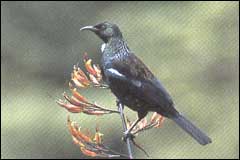Tui Facts
 The New Zealand tui |
The tui is a songbird member of the honeyeater family. It is endemic to New Zealand (like bellbirds and hihi) and has relations in Australia and New Guinea.
It has a black curved bill that it uses to eat nectar and fruit. Honeydew is a favourite food in beech forests.
The tui also eats insects. It gathers large invertebrates such as cicada and stick insects from tree trunks (gleaning). Sometimes tui catch insects in the air (hawking).
The tui is such a good song bird that it copies many of the forest sounds. It is often the first bird of the dawn chorus and the last to fall quiet in the evenings. Sometimes they are heard singing on moonlit nights.
The dark glossy feathers of tui shine green, bronze and blue in the sun. It has two distinctive white feathers at its throat.
Tui like to live in the top canopy of the forest. It perches in the highest branches of trees and flies over the tops of the trees to find food. Tui often fly long distances to find food and eat from both native and exotic plants. They are fiercely protective of their food and their young.
They can dive with closed wings from a great height to attack intruders. They also beat their wings and use calls to sound the alarm.
|
|
Parts of a Tui |
Features |
Major Functions |
|
E |
Feathers |
Water proof Dark and shiny in the sun – green, purple, black, bronze |
Warmth Puffed out when singing Camouflage |
|
Wings |
Slotted for wing noise Strong Versatile |
Flight Courtship Diving to protect food/young Chasing intruders Broken wing display to distract intruders |
|
|
Beak or Bill |
Curved Black |
Eating nectar, honeydew Gleaning insects Hawking insects from the air Clicking to chasing trespassers |
|
|
Legs and Feet |
Black |
Perching |
|
|
Eggs |
3-4 elliptical white or pink, reddish brown specks 14 days to hatch Nest in outer branch of canopy or sub-canopy |
Reproduction |